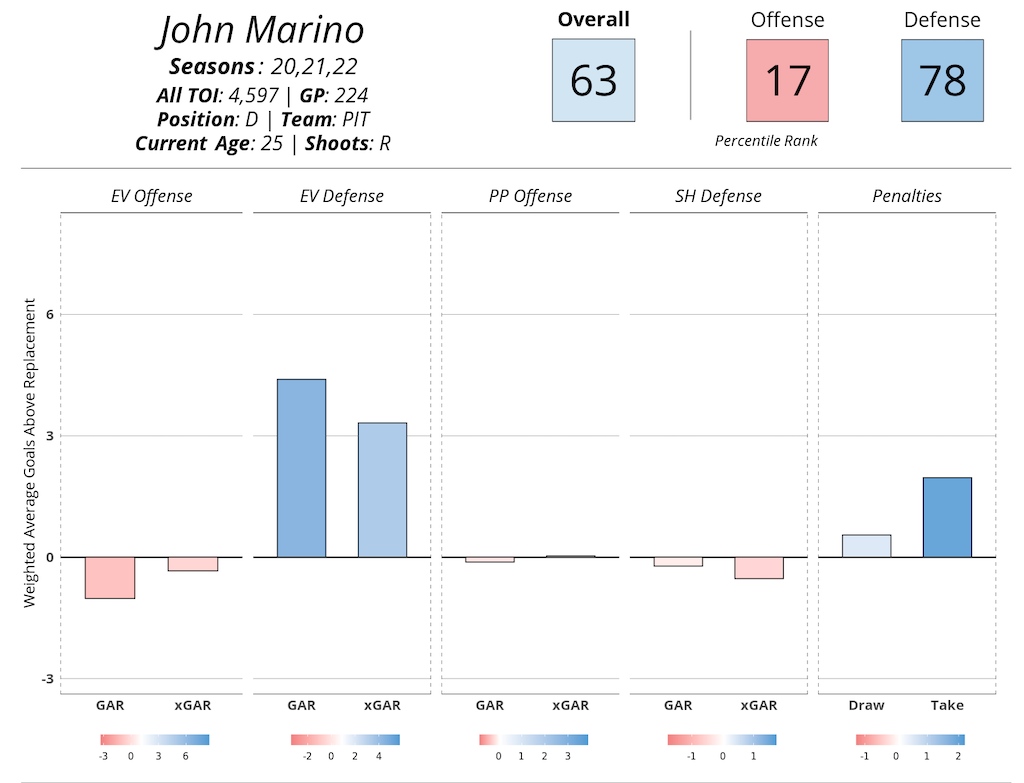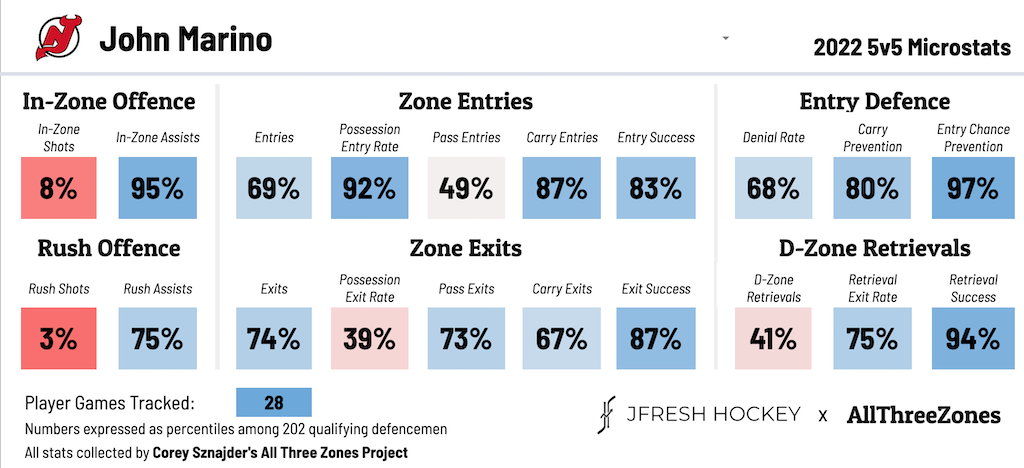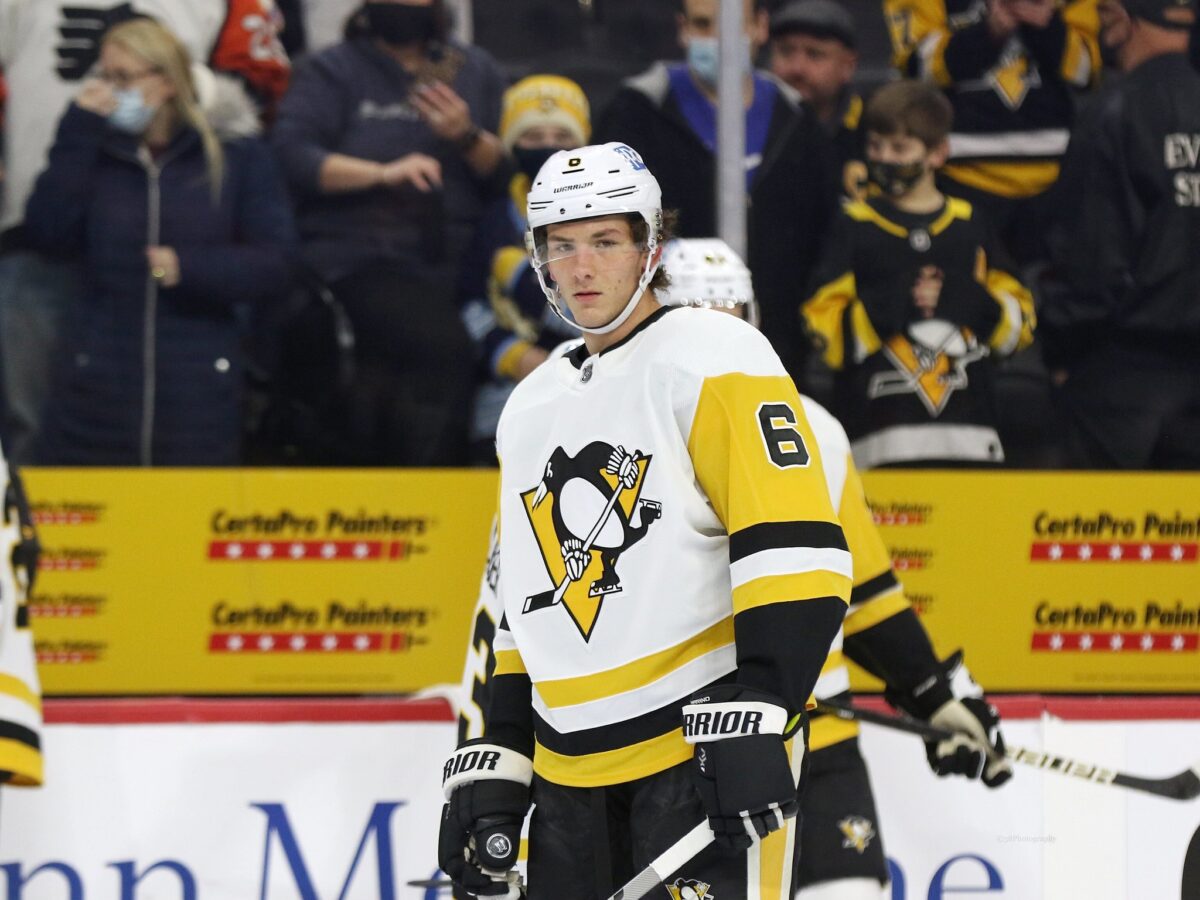The NHL draft and free agent frenzy may be over, but the offseason continues to roll on for the New Jersey Devils. They acquired defenseman John Marino from the Pittsburgh Penguins early yesterday afternoon in exchange for Ty Smith and a 2023 third-round pick. Marino, 25 years old, had 25 points in 81 games this past season and is under contract for five more years at a cap hit of $4.4 million.
With the additions of Marino, Jonas Siegenthaler, Ryan Graves and Dougie Hamilton, the Devils’ blue line has undergone a massive transformation over the last year. Where does Marino fit in a now-talented defense core? And what does he bring that the team was missing beforehand? Let’s take a look.
Marino Adds Different Look To Devils Blue Line
The Penguins acquired Marino from the Edmonton Oilers in 2019 after it became apparent he wasn’t going to sign with them once his college career was over. Instead of losing him for nothing, the Oilers traded him to the Penguins for a sixth-round pick. He signed an entry-level contract with Pittsburgh shortly afterward and made his NHL debut in 2019-20, where he’d total 26 points in 56 games as a rookie.
Marino was quite the surprise in his first NHL season. Though he was a solid defenseman at Harvard for three years in the NCAA, not many expected him to contribute as a top-four defenseman right away, but he stepped up to the task. While he did produce at a 38-point pace as a rookie, defensively was where he excelled most. His even-strength defense was worth an expected goals above replacement (xGAR) of 6.5 in 2019-20, the top mark on the Penguins.
Having just completed his third season in the NHL, he’s solidified his reputation as more of a defensive defenseman. While he’s averaged 27 points per 82 games for his career, he’s actually regressed some offensively since his rookie season. But even then, he has plenty of value as an even-strength defender:

Though the Penguins have Kris Letang, they were not shy about playing Marino against tougher competition. Since he’s broken into the league, he’s played at least 32 percent of his minutes against elite competition (via Puck IQ) each season. He wasn’t the Penguins’ primary shutdown defender; Letang still gets all those assignments, but Marino was far from sheltered.
Part of what makes Marino a stout defensive defenseman is his ability to defend the rush. He has a good denial rate and is excellent at preventing chances on opponents’ zone entries. In addition to his rush defense, he’s also quite successful at retrieving the puck on opponents’ forechecks.
And though Marino may not have much to offer offensively, he can still move the puck. He skates well and gains the offensive zone with possession successfully quite often. He also excels at getting the puck out of the defensive zone cleanly, which the Devils have had trouble with over the last couple of seasons:

There’s plenty to like about what Marino adds to the Devils’ blue line. Aside from Siegenthaler, they don’t have a defenseman who defends the rush as well as Marino. He’ll never be Dougie Hamilton offensively, but he skates well and can move the puck effectively to start the attack. That’s what you look for in a modern NHLer, and his contract shouldn’t cause problems moving forward.
How Marino Affects Devils’ Cap Outlook
In acquiring Marino, the Devils add his $4.4 million cap hit while subtracting Ty Smith’s $863,333 cap hit. That leaves them with $12,997,500 in cap space with Miles Wood, Jesper Bratt, Jesper Boqvist and Vitek Vanecek to re-sign from their restricted free agents. After acquiring Marino, here’s how the Devils’ blue line stacks up contract-wise:
- Hamilton: $9 million cap hit (through 2027-28)
- Marino: $4.4 million cap hit (through 2026-27)
- Damon Severson: $4,166,666 cap hit (UFA in 2023)
- Graves: $3,166,667 cap hit (UFA in 2023)
- Jonas Siegenthaler: $1.125 million cap hit (RFA in 2023)
- Brendan Smith: $1.1 million cap hit (through 2023-24)
The Devils will have an interesting decision on their hands with Severson and Graves at some point in the next year. With the acquisition of Marino and prospects Luke Hughes and Šimon Nemec coming up, it’ll be interesting to see who they retain. Siegenthaler is likely in line for a relatively significant raise within the next year, as he’s becoming one of the best defensive defensemen in the league.
Because the Devils still have to re-sign Bratt, Vanecek and the rest of their RFAs, I’d expect another trade soon, but it likely won’t be a defenseman. I’d bet on it being a forward, with Andreas Johnsson seemingly the odd man out up front since he seemed to fall out of favor with coach Lindy Ruff to end 2021-22. That’d clear $3.4 million in cap space, leaving the Devils with $16,397,500 to work with, assuming he’s the one they trade.

In doing so, the Devils shouldn’t have much trouble fitting in new contracts for their remaining RFAs. There’s also a good chance Jonathan Bernier, who underwent hip surgery in December, starts the season on long-term injured reserve (LTIR). That’d give the Devils an additional $4.125 million to use, so even after trading for Marino, there’s probably room for another acquisition if general manager Tom Fitzgerald so chooses.
Marino’s Addition Opens Up Possibilities for Defense Pairs
Though it may not have seemed this way because the Devils finished with a 27-46-9 record, their top-four was pretty decent. Now with Marino in the mix, Ruff will have a lot more flexibility in what defense pairs he’ll be able to put together. Let’s start with what worked last season, with their Corsi for (CF%) and expected goal percentages (xG%) by their sides:
- Siegenthaler – Hamilton (50.9 CF%, 52.48 xG%)
- Graves – Severson (50.85 CF%, 52.21 xG%)
- Kevin Bahl/Brendan Smith – Marino
The Devils aren’t paying Hamilton $9 million a year for him to play second-pair minutes. Assuming he’s fully recovered from a broken jaw he suffered in January, he’ll be back on the top pair. Siegenthaler is the closest Hamilton will get to having Jaccob Slavin as his defense partner. And given the two have contrasting styles — Siegenthaler’s defensive game complements Hamilton’s offensive style well — they make for an ideal top pair. Graves and Severson both played hard minutes at different times last season and handled them well for the most part. They’re good skaters who can move the puck and have some offensive upside.
Related: Devils’ Ondrej Palat Signing Will Improve Top-6
That’d leave Marino on the third pair with Bahl, who had good moments during his call-up over the final few weeks of the 2021-22 season, or Brendan Smith. But it’s also easy to flip Marino and Severson in the lineup since the former handled second-pair minutes quite well in Pittsburgh:
- Siegenthaler – Hamilton
- Graves – Marino
- Smith/Bahl – Severson
There’s also the possibility of flipping Graves and Siegenthaler’s roles, which would leave the Devils with a Graves – Hamilton (52.72 CF%, 52.83 xG%) top pair and some combination of Siegenthaler – Marino/Severson on the second pair and Smith/Bahl – Marino/Severson to round out the final combo.

There are other defense pairs you can come up with, but regardless, Ruff has more options to form a quality blue line than he did a season ago with Marino in the mix. Injuries are an unavoidable part of an 82-game schedule, and you don’t know what COVID might look like once the winter rolls around. Having depth is key to a successful season, and the Devils have that on their blue line by acquiring Marino, plus the prospects they’ll have playing with the Utica Comets in the AHL.
What the Devils Give Up in Ty Smith
The Devils decided to part ways with their first-round pick from the 2018 draft. Ty Smith had a stellar junior career with the Spokane Chiefs (WHL), but it’s been a bit of a rollercoaster for him in his two NHL seasons. He had a decent rookie year in 2020-21, in which he produced at a 39-point pace over 82 games. But his sophomore campaign was a clear step back, as he finished with 20 points in 66 games last season.
Smith’s underlying numbers were among some of the worst in the league for defensemen in 2021-22, especially defensively. His even-strength defense was worth an xGAR of minus-4, placing him in the bottom 20 among blueliners. His power-play production, which was a big part of his rookie season, led to his scoring drying up.
Related: Devils’ Trade for Erik Haula is a Win-Win
Smith is unlikely to be an elite defender in his prime, but he’s also not as bad as he was in 2021-22. His value comes offensively, and playing in a less up-tempo system in Pittsburgh than he did with the Devils will help him since it should leave him less exposed defensively. Given the Penguins’ roster, I’d bet on him figuring it out at some point since he’s still only 22 years old, but he might not turn into what the Devils hoped for when they drafted him in 2018.
That’s likely why they pulled the trigger on trading Smith now. Did they give up on him too early? Time will tell, but the Devils did get a proven second-pair defender in Marino. He’s only 25 years old, so he fits the team’s timeline and is under contract at a reasonable cap hit for the next five years. He might not offer much offensively, but he’s a good skater, defends the rush well, and should fit in with the rush-style system the Devils play since he moves the puck efficiently. All in all, it was a good piece of business for Fitzgerald and the Devils as they continue to reshape their roster ahead of the 2022-23 season.
* * *
Advanced stats from Natural Stat Trick, Evolving-Hockey